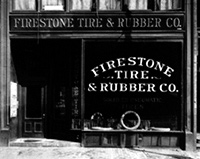On April 5, 1923, the Firestone Tire & Rubber Company introduced balloon tires, a new and improved form of inflatable tire that handled better and was much more economical than existing models, revolutionizing the automotive industry. Many cars and trucks of the time were outfitted with solid rubber tires. They were heavy, handled poorly, and provided terrible gas mileage.
Solid tires weren’t the only option, though. A form of inflatable, the pneumatic tire, had existed since the nineteenth century. These tires are made with a flexible material attached to a metal rim with rubber tread on the outside. They are inflated by pumping highly compressed air into the gap between the flexible material and the rim. They provided shock absorption and handling benefits over solid tires only for vehicles with large tires, such as farm equipment. Solid tires were more economical for smaller vehicles like cars.
Then, in 1923, Firestone redefined the concept of the inflatable tire by introducing a balloon between the outer material and the rim. This balloon, when inflated, provided several advantages. It was a design that was easier and cheaper to produce than pneumatic or solid tires and offered superior handling and cushioning, leading to better gas mileage. The cost savings and improved handling made driving accessible to a broader audience, and the ability to handle more varied terrains was a game-changer for cars of the time.
Since then, balloon tires have been the standard for the automotive industry. The introduction of balloon tires marked a significant shift in the industry, making driving more accessible and enjoyable for a wider range of people. The ‘balloon’ in balloon tires is an ‘inner tube,’ a term that has become synonymous with this type of tire.

